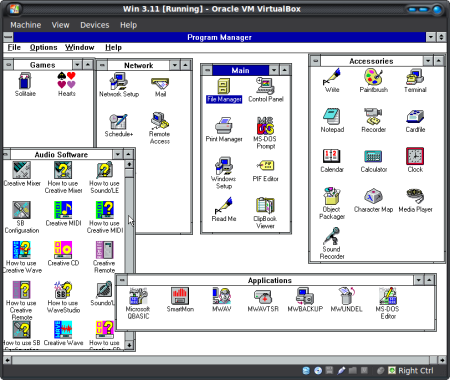Windows 95 OSR 2. Windows 95 offered, at long last, a well designed document-oriented desktop shell that worked much like the 1984 Macintosh Finder. It also included a new way of finding installed applications through a 'Start' menu. And it included the same networking abilities as Windows.
Version::::Games supported:DOSBox 0.74-3 (975)(2.67%)(2.15%)(3.79%)891 (91.38%)DOSBox 0.73 (620)(2.26%)(2.10%)(2.10%)580 (93.55%)DOSBox 0.72 (708)(5.65%)(2.82%)(3.95%)620 (87.57%)DOSBox 0.71 (151)(18.54%)(3.31%)(4.64%)111 (73.51%)DOSBox 0.70 (944)(2.22%)(1.38%)(3.18%)880 (93.22%)DOSBox 0.65 (715)(4.90%)(3.64%)(5.45%)615 (86.01%)DOSBox 0.63 (912)(8.22%)(4.71%)(4.93%)749 (82.13%)DOSBox 0.62 (391)(13.81%)(6.14%)(6.91%)286 (73.15%)DOSBox 0.61 (998)(8.72%)(5.81%)(6.81%)785 (78.66%)DOSBox 0.60 (768)(14.19%)(8.72%)(9.38%)520 (67.71%)DOSBox 0.58 (1141)(23.05%)(1.23%)(1.67%)845 (74.06%).
In this project we will run Windows 95 on. Download DOSbox0.74 and w95 from I've got the Win 95 image. Windows 95 in your browser. The only thing the emulator has access to is the disk image of Windows 95 temporarily. I installed Windows 95 in DOSBox.Old guide wrote:You just can't do it while in DOSBox's own DOS shell-you need to boot up from pure DOS. Let me know if you want anything elaborated; I kind of wrote this in a hurry since I've got a ton of other work to get done today and should really be getting started 1.
Get a boot disk First off, get an MS-DOS boot disk. You'll need a.img file. I myself used from. I don't know exactly which versions of MS-DOS will work, but I suppose 7 should be fine too.I've read that you can cheat Windows into accepting a different version by using set ver 6.0, but I can't confirm this myself since if you use 6.22 you'll never run into this problem. Make sure this file is in your DOSBox directory.Make a hard disk image You can do this using the bximage program that comes with Bochs. Contains a built in command for creating these from within DOSBox. (Would be awesome if that could be merged with the main branch.) Making an image using bximage is extremely straightforward.

There's a section on using it too. All you really need to remember when using bximage is the cylinder count, since everything else is standardized and shouldn't be changed.In my example I'm making a 400 MB image which has 812 cylinders. Only flat images are supported (as of this time of editing).Sparse images will not be recognized. However, it's possible to still compress flat files using your host OS's filesystem; in Windows XP, this is the default behavior (hence the blue filename).Copy this file (let's call it c.img) to your DOSBox directory.
Mount and format your new hard disk image So now we have a hard disk image that we're going to be installing Windows 95 on. The problem is it doesn't have a filesystem yet. This is where our boot disk first comes in. Start up DOSBox and type the following: Code: imgmount 2 c.img -size 512,63,16,812 -t hdd -fs none Note: you may need to replace c.img with the name you gave your image file, and replace 812 with the cylinder count you used when creating the file using bximage. It should say Drive number 2 mounted as c.img.You might notice that we're not giving it a drive letter: basically, every drive needs to have a filesystem, which is a sort of file index, before it can be used properly. Without a filesystem (like FAT32, NTFS, HFS+, etc.) a filesystem is just empty, unorganized space that the operating system can recognize but can't really do anything with, so until we fix this problem we can't mount it under C or any other drive letter yet. Modifying filesystems on a drive is called partitioning.
Now type the following: Code: boot 622c.img DOSBox will now boot up from the MS-DOS boot disk. The first thing we'll do is use fdisk to create a filesystem. Run fdisk, choose option 1 (Create DOS partition or Logical DOS Drive), then option 1 (Create Primary DOS Partition).When asked if you want the new partition to comprise the whole hard disk, choose Y. A system restart will be prompted. Press enter; DOSBox will quit.
Win95 Img Download

Now that we have our newly partitioned drive, we need to format it to effectively bring it to a completely empty and consistent state so that we can start putting files on it.To do so, we need to restart DOSBox and boot back into MS-DOS. This time, however, we'll mount our drive differently: Code: imgmount c c.img At this point, DOSBox should say 'Drive C is mounted as c.img'.If something is wrong, start this step over. Don't attempt to access the C drive from DOSBox's own DOS shell or you might make it unreadable for pure DOS.Now boot into MS-DOS by using the same command as last time: Code: boot 622c.img When you enter the DOS prompt, format your new C drive by typing: Code: format c: Note: if at this point DOSBox is incorrectly reporting the size of your hard disk, that may be due to either a DOSBox bug or a problem with MS-DOS. I don't know exactly which one, but I've found that hard disk images with a size of over 512 MB (or a cylinder count of over 1000?) tend to be problematic. They'll work, but you'll only be able to use a portion. Copy over setup files and start Windows 95 installation At this point you should have your Windows 95 disc ready.

The version should not matter all that much; I'm using a Dutch OEM version myself, the same one I got with my first Pentium computer about 17 years ago. It doesn't really matter if it's an image or not. The trick here is to copy the installation files over to your newly formatted hard disk and then perform the install from there.thingbuy.